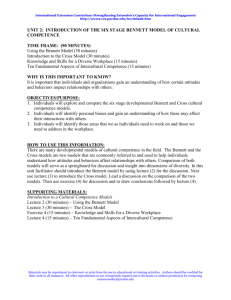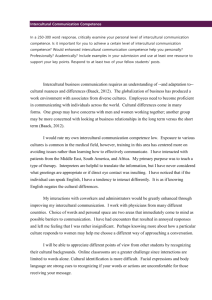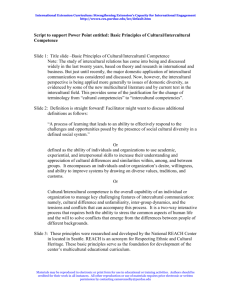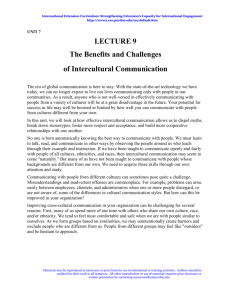Text
advertisement
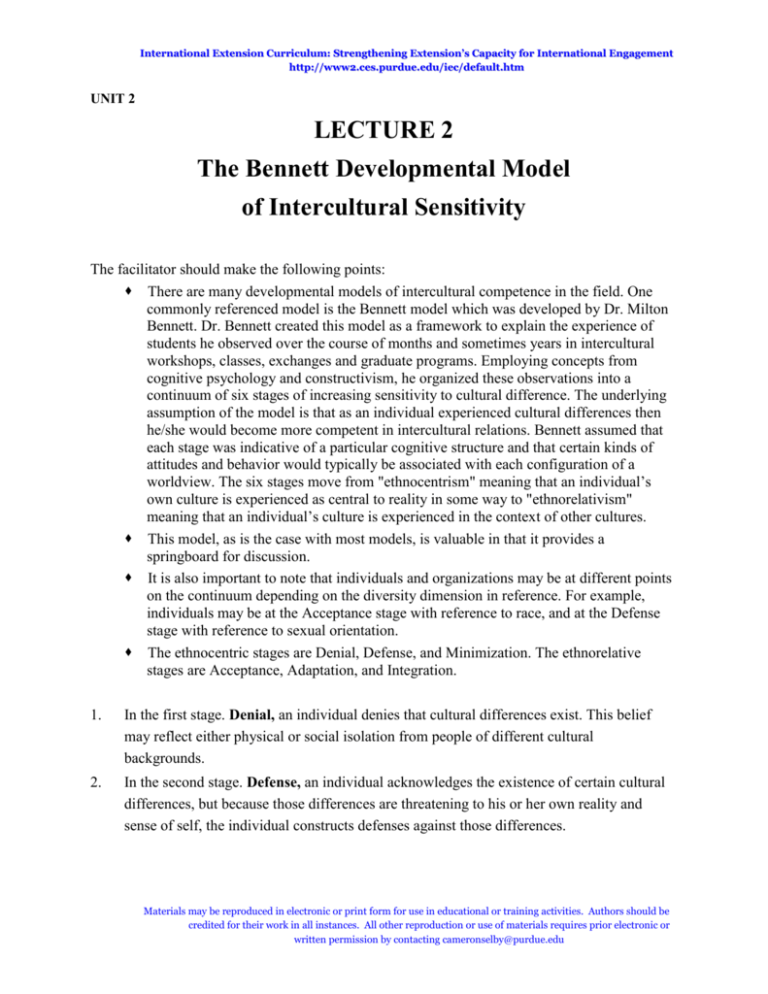
International Extension Curriculum: Strengthening Extension’s Capacity for International Engagement http://www2.ces.purdue.edu/iec/default.htm UNIT 2 LECTURE 2 The Bennett Developmental Model of Intercultural Sensitivity The facilitator should make the following points: There are many developmental models of intercultural competence in the field. One commonly referenced model is the Bennett model which was developed by Dr. Milton Bennett. Dr. Bennett created this model as a framework to explain the experience of students he observed over the course of months and sometimes years in intercultural workshops, classes, exchanges and graduate programs. Employing concepts from cognitive psychology and constructivism, he organized these observations into a continuum of six stages of increasing sensitivity to cultural difference. The underlying assumption of the model is that as an individual experienced cultural differences then he/she would become more competent in intercultural relations. Bennett assumed that each stage was indicative of a particular cognitive structure and that certain kinds of attitudes and behavior would typically be associated with each configuration of a worldview. The six stages move from "ethnocentrism" meaning that an individual’s own culture is experienced as central to reality in some way to "ethnorelativism" meaning that an individual’s culture is experienced in the context of other cultures. This model, as is the case with most models, is valuable in that it provides a springboard for discussion. It is also important to note that individuals and organizations may be at different points on the continuum depending on the diversity dimension in reference. For example, individuals may be at the Acceptance stage with reference to race, and at the Defense stage with reference to sexual orientation. The ethnocentric stages are Denial, Defense, and Minimization. The ethnorelative stages are Acceptance, Adaptation, and Integration. 1. In the first stage. Denial, an individual denies that cultural differences exist. This belief may reflect either physical or social isolation from people of different cultural backgrounds. 2. In the second stage. Defense, an individual acknowledges the existence of certain cultural differences, but because those differences are threatening to his or her own reality and sense of self, the individual constructs defenses against those differences. Materials may be reproduced in electronic or print form for use in educational or training activities. Authors should be credited for their work in all instances. All other reproduction or use of materials requires prior electronic or written permission by contacting cameronselby@purdue.edu International Extension Curriculum: Strengthening Extension’s Capacity for International Engagement http://www2.ces.purdue.edu/iec/default.htm 3. The third stage in Bennett’s model is Minimization. An individual in this stage acknowledges cultural differences, but trivializes them, believing that human similarities far outweigh any differences. The danger of this stage is that similarity is assumed rather than known. As Bennett writes, “In general, people who have experienced cultural oppression are wary of the ‘liberal’ assumption of common humanity. Too often, the assumption has meant ‘be like me.’” 4. In the fourth stage. Acceptance, an individual recognizes and values cultural differences without evaluating those differences as positive or negative. This stage moves an individual from ethnocentrism to ethnorelativism. First comes a respect for cultural differences in behavior, and then a deeper respect for cultural differences in values. 5. In the fifth stage. Adaptation, individuals develop and improve skills for interacting and communicating with people of other cultures. The key skill at this stage is perspectiveshifting, the ability to look at the world “through different eyes.” 6. The final stage of Bennett’s model is Integration. Individuals in this stage not only value a variety of cultures, but are constantly defining their own identity and evaluating behavior and values in contrast to and in concert with a multitude of cultures. Rising above the limitations of living in one cultural context, these individuals integrate aspects of their own original cultural perspectives with those of other cultures. References Bennett, M. J. (1993). Towards Ethnorelativism: A developmental model of intercultural sensitivity. In R. M. Paige (Ed.). Education for the intercultural experience. Yarmouth, ME: Intercultural Press. For further information, contact Dr. Milton Bennett. The Intercultural Communication Institute, 8835 S.W. Canyon Ln. Suite 238, Portland, OR. 97225. TEL: (503) 297-4622, FAX: (503) 297-4695, E-mail: ici(a>intercultural.org. Web: http://www.intercultural.org. Materials may be reproduced in electronic or print form for use in educational or training activities. Authors should be credited for their work in all instances. All other reproduction or use of materials requires prior electronic or written permission by contacting cameronselby@purdue.edu International Extension Curriculum: Strengthening Extension’s Capacity for International Engagement http://www2.ces.purdue.edu/iec/default.htm UNIT 2 LECTURE 3 The Cross Model of Intercultural Competence The facilitator should emphasize the following points: A. Another model of intercultural competence was originally developed by Terry Cross to describe stages of competence at the organizational level, but it has since been adapted for use at the individual level. It is instructive to note the similarities and differences between the Cross and Bennett models. B. While some of the labels used by Cross for the stages of intercultural competence are inappropriate (e.g., "blindness"), this is a useful model for looking at the process of working effectively in a diverse workplace. C. The six stages of Terry Cross's intercultural competence model are 1. Cultural Destructiveness This is the most negative end of the continuum represented by attitudes, policies, and practices that are destructive to cultures and consequently to the individuals wit the cultures. Individuals and organizations in this phase: • View culture as a problem. • Believe that if culture can be suppressed or destroyed, people will be better off. • Believe that people should be more like the "mainstream." • Assume that one culture is superior and should eradicate "lesser" cultures. At the societal level, this viewpoint taken to the extreme leads to such things as genocide. An example of this occurred when the Bureau of Indian Affairs mandated boarding schools that decimated the cultures of many Native American tribes. 2. Cultural Incapacity (corresponds with the Denial stage of the Bennett Model) Individuals and organizations in this phase: • Lack cultural awareness and skills. • May have been brought up in a homogeneous society and been taught to behave in certain ways and have never questioned it. • Believe in racial superiority of a dominant group and assume a paternalistic posture toward others. • Maintain stereotypes. • At the organizational level, this translates into supporting segregation or having lower expectations of persons from other cultures. Materials may be reproduced in electronic or print form for use in educational or training activities. Authors should be credited for their work in all instances. All other reproduction or use of materials requires prior electronic or written permission by contacting cameronselby@purdue.edu International Extension Curriculum: Strengthening Extension’s Capacity for International Engagement http://www2.ces.purdue.edu/iec/default.htm 3. Cultural Blindness (corresponds with Bennett's Minimization stage) At the midpoint in the continuum, the system and its agencies provide services with the expressed intent of being unbiased. Individuals in this phase • See others in terms of their own culture and claim that all people are exactly alike. • Believe that culture makes no difference. "We are all the same." • Believe that all people should be treated in the same way regardless of race, etc. At the organizational level, services are so ethnocentric that they are virtually useless to all but the most assimilated. 4. Cultural Pre-Competence (corresponds with Bennett's Acceptance stage) Individuals and organizations in this phase: • Recognize that there are cultural differences and start to educate themselves and others concerning these differences. • Realize their shortcomings in interacting within a diverse environment. • May become complacent in their efforts. At the organizational level, an attempt is made to address diversity issues by, for instance, hiring a diverse staff, offering cultural sensitivity training, promoting diverse staff to upper management, etc. 5. Basic Cultural Competence (corresponds with Bennett's Adaptation stage) Individuals and organizations in this phase: • Accept, appreciate, and accommodate cultural difference. • Value diversity and accept and respect differences. • Accept the influence of their own culture in relation to other cultures. • Understand and manage the dynamics of difference when cultures intersect. • Are willing to examine components of cross-cultural interactions (communication, problem solving, etc.). At the organizational level, an effort is made to hire unbiased employees, to seek advice from communities of color, and to assess what can be provided to diverse clients. 6. Advanced Cultural Competence Individuals at this phase: • Move beyond accepting, appreciating, and accommodating cultural difference and actively educate less informed individuals about cultural differences. • Seek out knowledge, develop skills to interact in diverse environments, become allies with and are comfortable interacting with others in multicultural settings. At the organizational level, this translates into conducting research, hiring staff who are specialists in intercultural competence practices, and acting as an advocate. Reference: Cross, T. (1988, Fall). Services to minority populations: Cultural competence continuum. Focal Point, 3. Materials may be reproduced in electronic or print form for use in educational or training activities. Authors should be credited for their work in all instances. All other reproduction or use of materials requires prior electronic or written permission by contacting cameronselby@purdue.edu International Extension Curriculum: Strengthening Extension’s Capacity for International Engagement http://www2.ces.purdue.edu/iec/default.htm UNIT 2 EXERCISE 3 Knowledge and Skills for a Diverse Workplace Objective: Time: Materials: Directions: Learning Point: To identify the knowledge and skills necessary to work effectively in a diverse workplace. 15 minutes • Flip chart • Markers 1. Facilitator should use the Cross & Bennett models to identify some of the knowledge and skills necessary to work effectively in a diverse workplace. 2. Discuss and list the participants' responses. 3. If participants have missed any key skills such as cross-cultural communication, conflict resolution, or team building, you should add them. Both models emphasize the importance of strong working relationships and skills such as cross-cultural communication and conflict resolution to achieve this. Materials may be reproduced in electronic or print form for use in educational or training activities. Authors should be credited for their work in all instances. All other reproduction or use of materials requires prior electronic or written permission by contacting cameronselby@purdue.edu International Extension Curriculum: Strengthening Extension’s Capacity for International Engagement http://www2.ces.purdue.edu/iec/default.htm UNIT 2 LECTURE 4 Ten Fundamental Aspects of Intercultural Competence The facilitator should cover the following points: These are ten fundamental aspects for successful development of intercultural competence that will serve as the foundation for the imaginary journey individuals and organizations ensue to become culturally competent in diverse communities and the workplace: Feel free during the discussion to add on to this list. Detection of an individual’s own ethnocentrism; Being aware of and working at controlling own biases and how these may affect interactions with others; Knowledge of institutional barriers that prevent some cultural groups from accessing resources; Accepting and valuing differences; Stressing things in common Encouraging solidarity; Training of reasonable conflict-techniques – dealing with cultural conflicts and cultural relativism; Awareness of the possibility to learn from each other and to enrich lives through cultural contact; and Remove frontiers by understanding the global responsibility of everyone. Effective communication skills Materials may be reproduced in electronic or print form for use in educational or training activities. Authors should be credited for their work in all instances. All other reproduction or use of materials requires prior electronic or written permission by contacting cameronselby@purdue.edu
